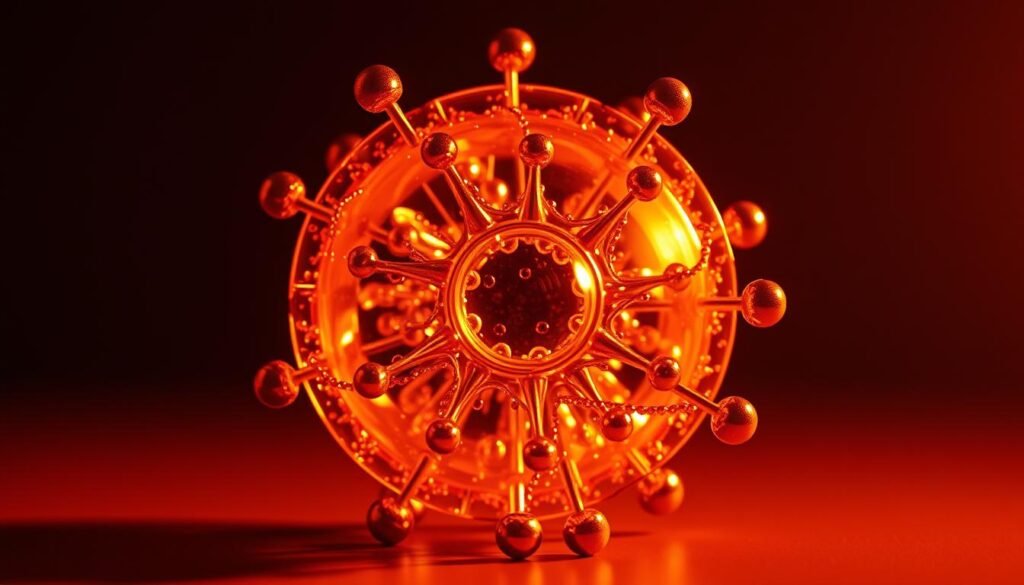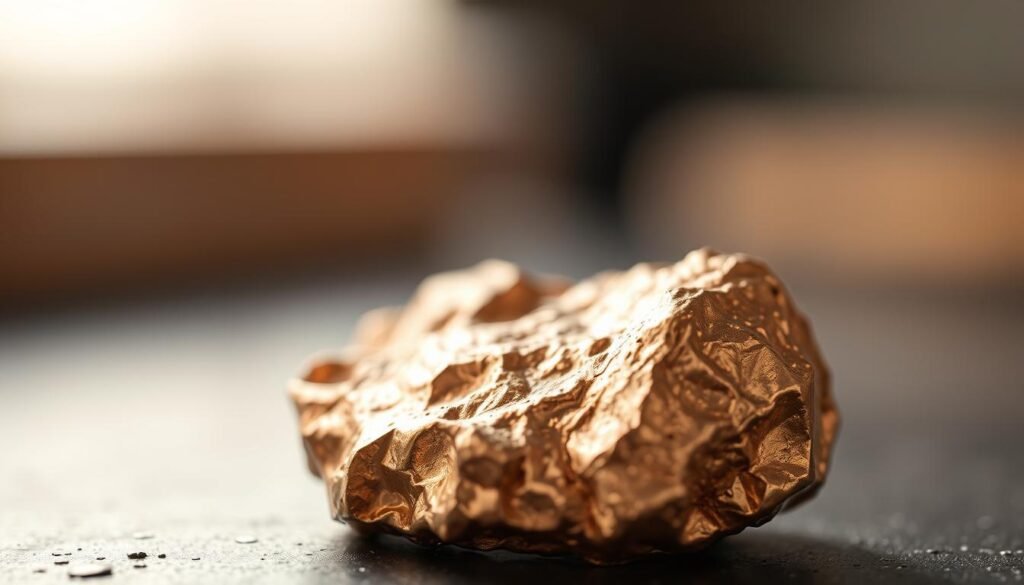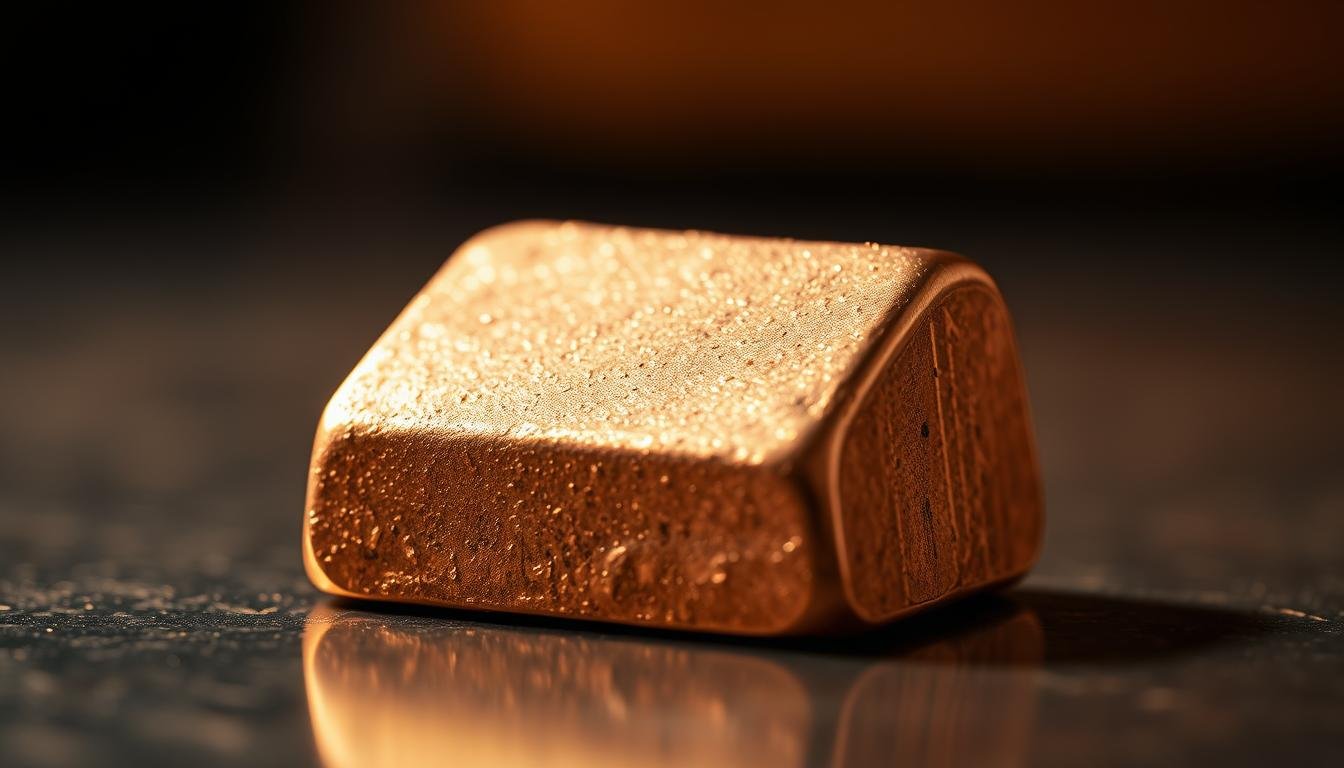The density of copper is key to its many uses in different fields. We’ll explore important facts about copper’s density. This knowledge is essential in science and engineering.
Knowing copper’s density helps us understand its role in areas like electronics, plumbing, and construction. It aids in making smart choices when picking materials.
Understanding the Importance of Density in Materials
Density is key in materials science. It’s the mass of a substance per unit volume. This property affects many things, like strength and how materials handle heat and electricity.
In engineering, knowing how density relates to material properties is vital. Different materials have different densities. This affects how they react to stress, heat, and electricity. For example, denser materials are often stronger, making them great for building and structures.
On the other hand, lighter materials are perfect for when you need something that’s not heavy. This is true in fields like aerospace. The connection between density and material properties helps engineers create better products in many areas.
What is the Density of Copper?
Understanding copper’s density is key to knowing its physical properties and uses. The density shows how tightly copper atoms are arranged. This affects its performance in different situations.
Definition and Calculation of Density
The definition of density is simple: it’s the mass of a substance divided by its volume. This is written as Density (ρ) = Mass (m) / Volume (V). Getting the mass and volume right is critical for any material, like copper, which is widely used.
Standard Density Value of Copper
The standard density of copper is about 8.96 grams per cubic centimeter (g/cm³) or 8,960 kilograms per cubic meter (kg/m³). This high density means copper has a tight atomic structure. This structure makes copper great at conducting heat and electricity.
Because of these properties, copper is perfect for electronics and building materials.
Physical Characteristics of Copper
Copper’s physical traits are closely tied to its atomic structure and density. Knowing how these properties work together gives us key insights into copper’s uses.
Atomic Structure and Density Relationship
Copper’s atomic structure is key to its density. With 29 protons and electrons, copper has a dense and stable setup. This makes copper heavy for its size, thanks to its atoms being packed tightly.
This tight packing also boosts copper’s ability to carry electricity and heat well. It’s a big reason why copper is so good at these tasks.
Impact of Density on Conductivity
Density and conductivity in copper go hand in hand. A higher density means electrons can move more easily, making copper a top conductor. Its atomic structure helps electrons flow with little resistance.
This makes copper perfect for electrical wiring and parts. Even when faced with tough conditions, copper keeps its conductivity high. This makes it essential for many industrial uses.

| Property | Value |
|---|---|
| Atomic Number | 29 |
| Density (g/cm³) | 8.96 |
| Electrical Conductivity (S/m) | 5.8 x 10^7 |
| Thermal Conductivity (W/(m·K)) | 401 |
How to Measure the Density of Copper
Measuring copper density requires precise techniques and reliable tools. It’s important for many fields, like engineering and quality control. The right tools are key to getting accurate measurements.
Tools and Techniques for Measurement
Common methods include using analytical balances for mass and graduated cylinders for volume. High-precision balances are vital for accurate copper mass readings. These are then combined with volume measurements to find the density.
Knowing your tools well helps get reliable results. This is important for any project.
Utilizing the Water Displacement Method
The water displacement method is a simple and effective way to measure copper density. It involves submerging a copper sample in water in a graduated cylinder. The volume of water displaced is equal to the copper’s volume.
This method is great because it makes volume easy to measure. To find the density, use the formula:
Density (ρ) = Mass (m) / Volume (V)
This method helps calculate copper density accurately. Remember, water density changes with temperature. At 20°C, water’s density is 0.998 g/cm³. This method is useful for any copper project. For more on metal density, visit this resource.
The Role of Copper’s Atomic Number in Its Properties
The Copper atomic number, which is 29, greatly affects its unique traits. This number shows how many protons are in a copper atom. It also tells us where copper is on the periodic table.
The electron setup of copper, [Ar] 3d10 4s1, shows it has one free electron. This is why copper is so good at conducting electricity and heat.
Copper’s atomic number makes it very conductive. This is why it’s used a lot in electrical wiring. It’s also very malleable and ductile, making it useful in many ways.
Copper can easily make alloys, which makes it even more useful. This is why it’s used in so many industries.
Knowing how copper’s atomic number affects its reactivity helps us understand it better. Copper’s behavior shows how important its atomic structure is. For more info on copper, check out this informative source.
Diving Deeper into the Chemical Properties of Copper
Copper’s chemical properties are key to its uses and flexibility. Knowing its oxidation states helps us understand how it acts in different settings.
Oxidation States and Their Significance
Copper has two main oxidation states: +1, called cuprous, and +2, known as cupric. These copper oxidation states affect its reactivity and ability to form complex ions. They are important in many industrial uses, like chemical catalysis and making alloys that resist corrosion.
Reactivity of Copper Based on Density
Copper’s reactivity is influenced by its density and oxidation states. Higher density copper interacts better with other elements and compounds. This makes it more useful in technology.
This increased reactivity is key in copper’s role in industrial processes. For example, it helps form protective layers that prevent corrosion.

Density of Copper Compared to Other Metals
The density of a material is key in many uses. Copper, aluminum, and steel have different densities. Copper is 8.96 g/cm³, aluminum is 2.70 g/cm³, and steel is between 7.75 and 8.05 g/cm³. This shows how each metal’s density affects its weight and use.
Comparative Analysis with Aluminum and Steel
Looking at copper, aluminum, and steel, density is important. Copper is denser, making it strong for electrical needs. Aluminum is lighter, good for aerospace. Steel is in the middle, useful for building and machines.
Application Implications of Density Variations
Density affects how metals are used. Copper’s density makes it great for electricity. Aluminum is chosen for its lightness. Steel is versatile for many uses.
Knowing about density helps engineers choose the right materials. This improves performance in many fields. For more on this, check out this resource.
Applications of the Density of Copper in Industry
Copper’s density is key in many industries, like electrical wiring and plumbing. Its unique qualities make it essential for various uses. This is why copper is often the first choice for these critical tasks.
Electrical Wiring and Conductors
Copper’s high density and great conductivity make it top for electrical wiring. It can carry a lot of electric current with little loss. This is why copper is used in motors, transformers, and more, ensuring energy is sent efficiently.
Use in Plumbing and Construction
In plumbing, copper’s density means it’s durable and resistant to corrosion. This is vital for lasting installations. Copper pipes can handle high pressures and temperatures well. This makes copper valuable in construction, improving the quality of buildings.
| Application | Properties of Copper | Benefits |
|---|---|---|
| Electrical Wiring | High density, excellent conductivity | Efficient energy transport, minimal loss |
| Plumbing | Durable, corrosion-resistant | Long-lasting, reliable under pressure |
The Influence of High Temperatures on Copper Density
High temperatures greatly affect the density of materials, like copper. When heated, copper expands. This change is key for engineers and designers, as it impacts how materials perform and stay stable.
Thermal Expansion Considerations
Copper expands when heated, increasing its volume and decreasing its density. This change is important for engineers. They must plan for copper’s expansion to prevent damage during temperature changes.
Impact on Industrial Applications
In industry, high temperatures can change copper’s density, affecting its use. Understanding how copper reacts to heat is critical. This knowledge helps improve the performance and reliability of materials in motors and other equipment.

How Copper’s Density Affects Its Alloys
Copper alloys, like brass and bronze, have different densities because of their makeup. Brass, made mostly of copper and zinc, is lighter than pure copper. This makes it great for things that need to be strong but not too heavy. On the other hand, bronze, made of copper and tin, is used in tough and corrosive places because of its durability.
Understanding Brass and Bronze Compositions
Looking at brass and bronze, we see how their metal mix affects their density. Both are strong and resist corrosion well.
- Brass: Mainly copper and zinc, it’s dense but malleable.
- Bronze: Copper and tin mix, it’s durable and fights corrosion well.
Density Implications in Mechanical Applications
The density of copper alloys affects how they work mechanically. Things like hardness, resistance to corrosion, and durability depend on density.
| Alloy Type | Composition | Typical Density (g/cm³) | Mechanical Applications |
|---|---|---|---|
| Brass | Copper + Zinc | 8.4 – 8.73 | Electrical fittings, fasteners |
| Bronze | Copper + Tin | 8.7 – 9.0 | Marine hardware, sculptures |
Changing the mix of metals in alloys can make them better for many uses. This includes machines, space, and the sea. Knowing how copper’s density affects its alloys can lead to new tech and ways to make things.
Future Implications of Understanding Copper’s Density
As technology advances, copper’s density plays a key role. Its unique density affects its use in many areas. This drives new discoveries in material science.
These discoveries are vital for making better alloys, efficient electrical parts, and systems that manage heat well.
Density goes beyond simple numbers. It’s at the heart of big leaps in energy saving and sustainability. Engineers and scientists work together to improve copper’s properties. They aim to make products that use less energy.
Changing copper’s density can lead to better materials. For instance, making copper alloys lighter and more conductive. This can make products more energy-efficient during use and production.
Improvements in making and shaping copper will also rely on understanding its density. This knowledge can make products work better and waste less. The auto and aerospace industries will see big benefits from these changes.
| Aspect | Current Understanding | Future Outlook |
|---|---|---|
| Material Innovation | Current copper applications are limited by traditional properties | Potential for lightweight alloys and complex composites |
| Energy Efficiency | Standardized production processes | Tailored density for energy-saving applications |
| Sustainability | Recyclability already established | Improved processes reducing resource consumption |
Conclusion
Copper’s density is key in many industries, shaping the quality and function of products made from it. It has a density of about 8,960 kilograms per cubic meter. This makes copper great for carrying electricity and heat, essential in fields like electrical engineering, plumbing, and building.
Copper is also used in many areas, from making wires and electronics to parts of big machines. Knowing how density affects copper helps industries use its special qualities better. As technology grows, copper’s density and electrical abilities will likely lead to new discoveries and uses.
In short, copper’s density and uses show its vital role in today’s world. For more on copper’s density and its impact, check out this link. It explains why copper is a cornerstone of many advancements in our fast-changing world.
